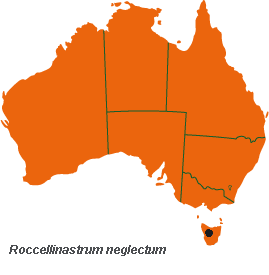



Australian Biological Resources Study
| Checklist of the Lichens of Australia and its Island Territories | ||
| Introduction | A–D | E–O | P–R | S–Z | Oceanic Islands | References | ||
| Roccellinastrum neglectum Henssen & Vobis | ||
| in A.Henssen, G.Vobis & B.Renner, Nordic J. Bot. 2: 595 (1982). T: L. Ianthe, c. 40 km south of Hokitika, Westland, South Island, New Zealand, 18 Sept. 1981, A.Henssen 27487a; holo: MB; iso: CHR, UPS. | ||
| Thallus fruticose, byssoid, whitish, forming spreading loosely attached colonies toc. 80 mm wide, composed of terete or partly flattened branched and densely entangled lobes, 0.2–0.4 (–0.8) mm wide, to 5 mm long. Hyphae 3.5–9.0 µm thick; lumen (0.5–) 1.0–2.0 µm wide. Photobiont cells (6–) 9–10 µm diam., aggregated in clusters near the surface of the lobes. Apothecia globose, immarginate, 0.3–0.4 mm diam., mostly pale pink, sometimes compound, ±stipitate, abundant at the tips or on the surface of the lobes. Epithecium pale yellow-brown, granular, colourless in KOH. Hymenium (25–) 30–40 µm thick, hyaline. Hypothecium hyaline, mostly 15–20 µm thick, sometimes elongated into a stipe. Asci cylindrical, (20–) 24–27 × 6.5–7.5 µm. Paraphyses c. 1.5 µm thick. Ascospores bacilliform, 5–7 × 1.0–1.5 µm, simple but sometimes with plasma bridges. Pycnidia predominantly at the tips of lobes, globose, 30–70 µm diam. Conidia bacilliform, 3.0–4.5 × 1.0 µm. CHEMISTRY: Thallus K–, KC–, C–, Pd+ red, UV+ rather weakly whitish; containing protocetraric and squamatic acids. |  |
|
| An extremely rare species in Tas. where it occurs on moist, smooth-barked, shaded tree trunks in lowland, cool-temperate rainforest in the north-western, ‘Tarkine’ region. Also known from New Zealand. | ||
| Kantvilas (2004c) | ||
| Checklist Index |
| Introduction | A–D | E–O | P–R | S–Z | Oceanic Islands | References |
This work is copyright. Apart from any use as permitted under the Copyright Act 1968, no part may be reproduced by any process without prior written permission from Australian Biological Resources Study. Requests and inquiries concerning reproduction and rights should be addressed in the first instance to Dr P. McCarthy. These pages may not be displayed on, or downloaded to, any other server without the express permission of ABRS.